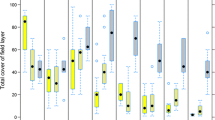Abstract
Vegetation growth on spoil placed on aSpartina patens andS. alterniflora marsh in Barnegat Bay, New Jersey, was examined for two years following spoil deposition. In areas where spoil was leveled to match the elevation of the marsh, the percent cover by the end of the first growing season ranged from 60 to 90%. By the second year, cover was 100% in all study plots. Even during the first year, there was no difference in species diversity or vegetation species in the experimental and control areas. The percentage of shrubs did not increase on the perturbed (spoil) areas compared to the control plots. During the first year, but not the second, live and dead biomass was greater in the perturbed areas compared to the control plots. In an area where the spoil was thicker succession was exceedingly slow and there was only about 5% grass cover by the end of the first growing season. BecauseSpartina colonizes primarily by rhizome growth, the comparatively slow recovery was attributed to the inability of the grass to penetrate the thick spoil layer.
Similar content being viewed by others
Literature Cited
Adams, D. A. 1963. Factors influencing vascular plant zonation in North Carolina salt marshes.Ecology 44:445–456.
Bourn, W. S., andC. Cottam. 1939. The effect of lowering water levels on marsh wildlife.Trans. N. Am. Wildl. Conf. 4:343–350.
Bourn, W. S., and C. Cottam. 1950. Some biological effects of ditching tidewater marshes. Res. Report 19, U.S. Fish and Wildlife Service.
Burger, J., andJ. Shisler. 1978. The effects of ditching a salt marsh on colony and nest site selection by Herring Gulls (Larus argentatus).Am. Midl. Nat. 100:54–63.
Darnell, R. M. 1964. Organic detritus in relation to secondary production in aquatic communities.Verh. Intern. Verein. Limnol. 15:462–470.
Ferrigno, F., andD. M. Jobbins. 1968. Open marsh management.Proc. N.J. Mosq. Exterm. Assoc. 55: 104–115.
Ferrigno, F., andD. M. Jobbins. 1975. Salt marsh water management for mosquito control.Proc. N.J. Mosq. Exterm. Assoc. 62:30–38.
Keefe, C. W. 1972. Marsh production: a summary of the literature.Contrib. Mar. Sci. 16:163–181.
Knight, J. B. 1934. A salt marsh study.Am. J. Sci. 28:161–181.
Landers, J. F., A. S. Johnson, P. H. Morgan, andW. P. Baldwin. 1976. Duck foods in managed tidal impoundments in South Carolina.J. Wildl. Manage. 40:721–728.
Mendelssohn, I. A., andK. L. Marcellus. 1976. Angiosperm production of three Virginia marshes in various salinity and soil nutrient regimes.Chesapeake Sci. 17:15–23.
Miller, W. R., andF. E. Egler. 1950. Vegetation of the Wequetequock-Pawcatuck tide marshes, Connecticut.Ecol. Monogr. 20:143–172.
Odum, E. P. 1961. The role of tidal marshes in estuarine production.N.Y. State Conserv. 15:12–15.
Odum, E. P. 1970. Utilization of the direct grazing and plant detritus food chains of the striped mulletMugil cephalus, p. 222–240.In J.H. Steele (ed.), Marine Food Chains.
Provost, K. W. 1977. Tidal datum planes circumscribing salt marshes.Bull. Mar. Sci. 26:558–563.
Redfield, A. C. 1972. Development of a New England salt marsh.Ecol. Monogr. 42:201–237.
Romig, R. F. 1973. Growth and reproduction ofSpartina, Ph.D. Thesis, Univ. of Delaware.
Shanholtzer, G. F. 1974 Relationship of vertebrates to salt marsh plants, p. 463–476.In R. J. Reimold and W. H. Queen (eds.), Ecology of Halophytes. Academic Press, Inc., New York.
Shisler, J., andD. M. Jobbins. 1977. Salt marsh productivity as affected by the selective ditching technique, open marsh water management.Mosq. News, 37:631–636.
Shisler, J., F. H. Lesser, andT. L. Schultze. 1975. Re-evaluation of some effects of water management on the Mispillion Marsh, Kent County, Delaware.Proc. N.J. Mosq. Exterm. Assoc. 66:276–278.
Shisler, J., T. L. Schultze, andB. L. Howes. 1978. The effect of the marsh elder (Iva frutescens) on the standing crop biomass ofSpartina patens and associated wildlife.Biol. Conserv. 14:159–166.
Smith, J. B. 1907. The New Jersey salt marsh and its improvement. Bull. N.J. Agr. Exp. Ext. Stat. No. 207, Rutgers University, New Brunswick, N.J.
Valiela, I., andJ. M. Teal. 1974. Nutrient limitation in salt marsh vegetation, p. 547–563.In R. J. Reidmold and W. H. Queen (eds.), Ecology of Halophytes. Academic Press, Inc., New York.
Zar, J. H. 1974. Biostatistical Analysis. Prentice Hall, Inc., Englewood Cliffs, N.J.
Author information
Authors and Affiliations
Rights and permissions
About this article
Cite this article
Burger, J., Shisler, J. Succession and productivity on perturbed and naturalSpartina salt-marsh areas in New Jersey. Estuaries 6, 50–56 (1983). https://doi.org/10.2307/1351806
Received:
Accepted:
Issue Date:
DOI: https://doi.org/10.2307/1351806




